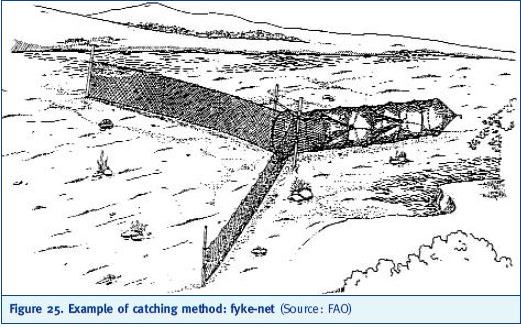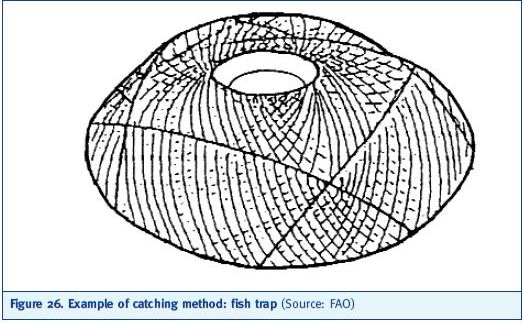Capture technology eel
The capture of all forms of juvenile eels uses a variety of systems, depending on local methods and the position of the catching equipment. A range of sampling methods has been used for studying glass eel recruitment in estuaries and freshwater. These methods include stow nets (McKinnon and Gooley 1998) and fyke nets (Figure 25), plankton nets, flow traps and dip or scoop nets (Silberschneider, Pease and Booth 2001).
These methods are expensive because they require continuous monitoring, multiple operators and have to be located in sites with specific physical characteristics. Using bundles of branches (Jellyman and Chisnall 1999) for collecting glass eels is cheaper and easier but, because it uses a wide range of interstitial spaces or too large a mesh size, larger eels can enter and prey on smaller glass eels.
Some glass eel fishing in Spain and Portugal uses hand nets and traps. In Portugal. “Hamen” gears are used (Ciccotti, Busilacchi and Cataudella 1999). Glass eels are caught in France by small trawlers using “wing nets” and “trawls”. The only legal fishing gear for this purpose in the UK is the hand net, which has been used for hundreds of years. The number of dip net licences issued for glass eels and elvers is 2 500. Yellow eels are caught with traps (about 1 000 licences) and fyke nets (about 3 700 licences) (UKEA 2000).
Glass eels are caught in Northern Ireland with ladder traps for restocking activities (Ciccotti, Busilacchi and Cataudella 1999).

Figure 25. Example of catching method: fyke-net (Source: FAO)
In several Mediterranean countries (Greece, Turkey, Albania, Egypt, Tunisia, Algeria, Morocco and Italy), the juvenile eel fishery has not always been included in legislation, although it is covered by EU Directive 1626/94, under the section for juvenile fisheries for aquaculture and restocking (Ciccotti, Busilacchi and Cataudella 1999).
The fisheries for European eels (Anguilla anguilla) have seen dramatic declines during the 1970s and 1980s, which has tentatively been attributed to the unrestricted increase in fishing effort (eel boxes, fyke nets and gill nets). Until the mid-1980s no measures were taken to determine and/or restrict the fishing effort. However, from 1985 the number of fyke nets was fixed; other gears were left unrestricted (Dekker 1991).
Silberschneider, Pease and Booth (2001) described a new glass eel collection system, which is based on special collectors that "attract glass eels by mimicking the complex natural habitat that glass eels seek in the wild". These collectors exploit surface roughness, protective tufts and other characteristics that are similar to the sea-grass beds that attract wild glass eels in the proximity of estuaries. This method is inexpensive, requires low maintenance, and provides a relative abundance of resettling glass eels.
In Japan elvers are attracted by bright lights, and are then caught in scoop nets at night, or fine meshed bag nets set across the river. Special elver traps may also be set near obstructions in the rivers, where the elvers are likely to congregate. In Taiwan Province of China, the elvers are caught with scoop nets, drag nets or eel traps (Figure 26) (Pillay 1995).
Short-fin glass eels and elvers are caught from the wild for stocking in culture facilities in North America (north of Mexico), using fine mesh fyke nets and dip nets (Page and Burr 1991). Licences are required, and the quantity allowed to be caught is related to the size of the production facilities.
American silver eels and yellow eels are captured with bottom trawls, electro-fishing, large commercial weir (interception) nets, pot fisheries and beach seines; all other gears are banned (EIFAC/ICES 2001). In the USA, legislation controls and licenses the fishery for eels, and includes gear fees and harvest locality limitations that vary from State to State. All the Atlantic States, with the exception of Florida and South Carolina, have responded to warnings and have cracked down on “eeling”. New Jersey has banned the use of fixed nets and creels and, from 2002, only allows fishermen to use handheld dip nets from February 15 to April 20. There is a legal eel fishery in South Carolina for residents only, with fyke and dip nets. The State’s glass eel season typically runs from January to March and harvest areas are limited. In Maine, glass eels are also caught with fyke or dip nets, with a limit of 5 fyke nets. The catching season runs from March 15 till June 15 (www.ecoscope.com/eelnews.htm).

Figure 26. Example of catching method: fish trap (Source: FAO)